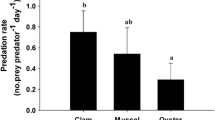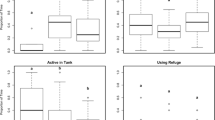Abstract
Sublethal burdens of lead impair behaviors critical to survival in a variety of animals. In a test arena, I measured refuge-seeking behaviors of adult, male, lined shore crabs from lead-free and lead-contaminated sites. The body sizes of the test groups did not differ although the mean total body lead burdens differed by over 2,300%. A lead-contaminated environment does not appear to affect growth. Each of the 31 crabs had at least six trials in the arena. The fraction of trials with more than one pause, number of pauses per trial, mean time per pause, and the fraction of time a crab spent in pauses did not differ between groups. The absence of behavioral effects of the lead burdens may be because a large portion of the lead burden was sequestered in the carapace. The neurological and other soft tissues would then have lower levels of lead. Predators that ingest primarily soft tissues would have little exposure to the lead burden of these crabs. Those that also ingest the carapace may benefit from its high calcium content that inhibits lead uptake from the gut, regardless of the location of lead in the crab body.
Similar content being viewed by others
References
Anonymous, (1990). Patuxent analytical control facility reference manual. Laurel, M.D.: Patuxent Wildlife Research Center.
Berge, J.A. and Brevik, E.M. (1996). Uptake of metals and persistent organochlorines in crabs (Cancer pagurus) and flounder (Platichthys flesus) from contaminated sediments: Mesocosm and field experiments. Mar. Pollut. Bull. 33, 46–55.
Burger, J. (1990). Behavioral effects of early postnatal lead exposure in herring gull (Larus argentatus) chicks. Pharmacol. Biochem. Behav. 35, 7–13.
Burger, J., Carruth-Hinchey, C., Ondroff, J. and McMahon, M. (1998). Effects of lead on behavior, growth, and survival of hatchling slider turtles. J. Toxicol. Environ. Health A55, 495–502.
Carlson, B.L. and Nielson, S.W. (1985). Influence of dietary calcium on lead poisoning in mallard ducks (Anas platyrhynchos). Am. J. Vet. Res. 46, 276–82.
Gupta, A. (1998). Metal accumulation by riverine and lacustrine populations of Angulyagra oxytropis (Benson) (Gastropoda: Viviparidae). Environ. Monitor. Assess. 50, 249–54.
Hiatt, R.W. (1948). The biology of the lined shore crab, Pachygrapsus crassipes Randall. Pacific Sci. 2, 135–213.
Hui, C.A. (2002). Lead distribution throughout soil, flora and an invertebrate at a wetland skeet range. J. Toxicol. Environ. Health. Part A 65, 1093–1107.
Janiga, M. and Zemberyova, M. (1998). Lead concentration in the bones of the feral pigeons (Columba livia): Sources of variation relating to body condition and death. Arch. Environ. Contam. Toxicol. 35, 70–4.
Jorgensen, P.D. (1975). Habitat preference of the light-footed clapper rail in Tijuana Marsh, California. Ms thesis, San Diego State University, San Diego CA.
Lefcort, H., Ammann, E. and Eiger, S.M. (2000). Antipredatory behavior as an index of heavy-metal pollution? A test using snails and caddisflies. Arch. Environ. Contam. Toxicol. 38, 311–16.
Lefcort, H., Meguire, R.A., Wilson, L.H. and Ettinger, W.F. (1998). Heavy metals alter the survival, growth, metamorphosis, and antipredatory behavior of Columbia spotted frog (Rana luteiventris) tadpoles. Arch. Environ. Contam. Toxicol. 35, 447–56.
Newman, M.C., Mulvey, M., Beeby, A., Hurst, R.W. and Richmond, L. (1994). Snail (Helix aspersa) exposure history and possible adaptation to lead as reflected in shell composition. Arch. Environ. Contam. Toxicol. 27, 346–51.
Rice, D.C. (1996). Behavioral effects of lead: Commonalities between experimental and epidemiologic data. Environ. Health Perspect. 104(Suppl. 2), 337–51.
deRivera, C.E. (2000). Belding's savannah sparrows eat eggs from live fiddler crabs. Wilson Bull. 112, 427–28.
Venugopal, B. and Luckey, T.D. (1978). Metal Toxicity in Mammals 2, Chemical Toxicity of Metals and Metalloids. New York, NY: Plenum Press.
Walsh, K., Dunstan, R.H. and Murdoch, R.N. (1995). Differential bioaccumulation of heavy metals and organopollutants in the soft tissue and shell of the marine gastropod, Austrocochlea constricta. Arch. Environ. Contam. Toxicol. 28, 35–9.
Warner, G.F. (1977). The Biology of Crabs. New York, NY: Van Nostrand Reinhold Co.
Weiss, J.S. (1976). Effects of mercury, cadmium, and lead salts on regeneration and ecdysis in the fiddler crab, Uca pugilator. Fishery Bull., US 74, 464–67.
Author information
Authors and Affiliations
Corresponding author
Rights and permissions
About this article
Cite this article
Hui, C.A. Lead Burdens and Behavioral Impairments of the Lined Shore Crab Pachygrapsus crassipes . Ecotoxicology 11, 417–421 (2002). https://doi.org/10.1023/A:1021049016604
Issue Date:
DOI: https://doi.org/10.1023/A:1021049016604




